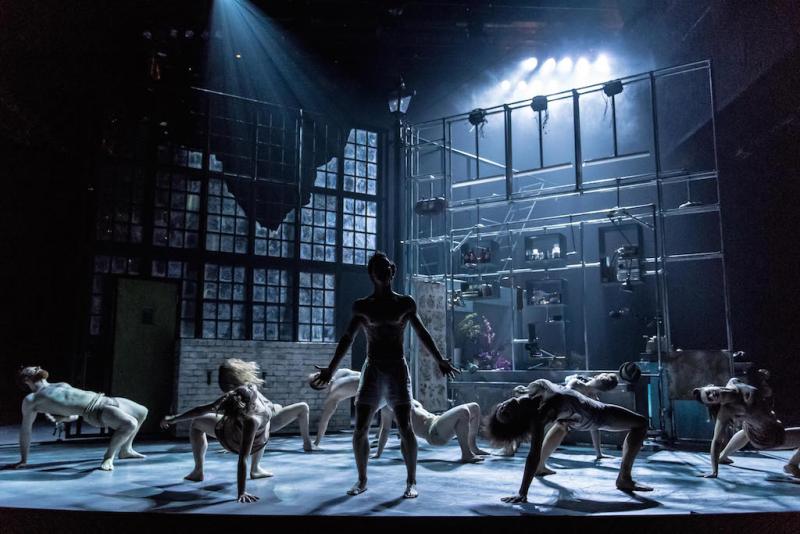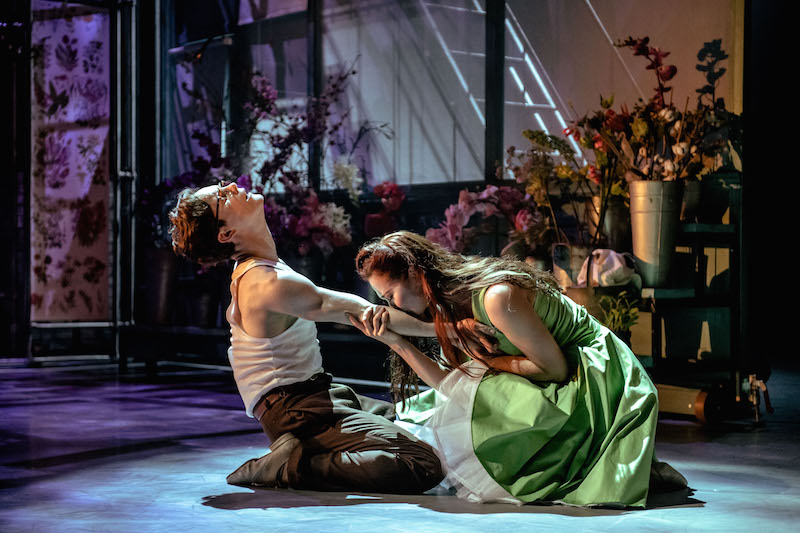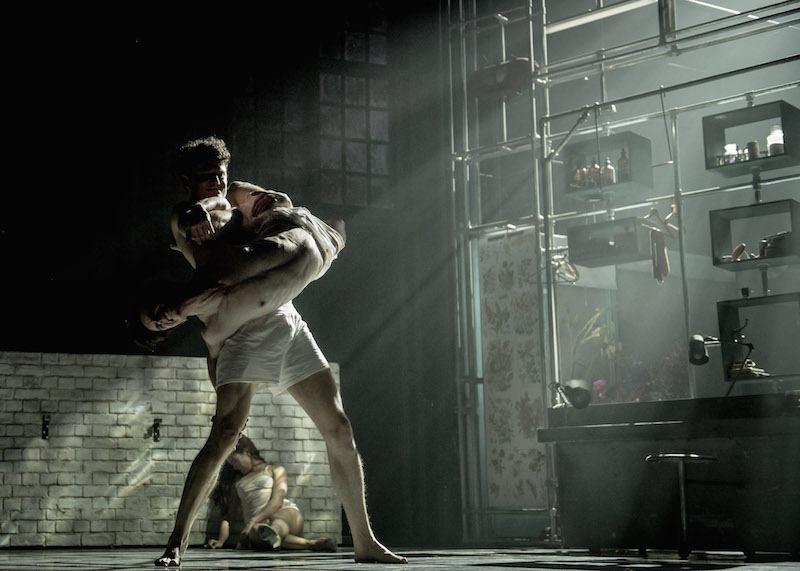Jekyll & Hyde, Old Vic | reviews, news & interviews
Jekyll & Hyde, Old Vic
Jekyll & Hyde, Old Vic
Dance version is loud and brash with all the horror and none of the mystery

From time to time theatre managements hit on the idea that danced drama should be part of their remit. Nick Hytner flirted with it at the National in his day with a run of productions for Lloyd Newson and his company DV8. Now Matthew Warchus, his feet barely under the desk at the Old Vic, has commissioned a show from a young choreographer who has Matthew Bourne’s crown in his sights.
Bourne has always been clever in his choice of stories, drawing on familiar plots to counter the obvious drawbacks of dance in the explaining department. Drew McOnie may think he’s following suit in Jekyll & Hyde. Few characters from 19th-century fiction, Dracula apart, spark such recognition as the good Scottish doctor and his psychopathic alter ego, and it’s a story that belongs to anyone who has ever referred to themselves in the third person, cursed their split personality or praised their better nature. For a choreographer looking for a narrative, blanket familiarity might seem the best possible start.
 But maybe not. This is McOnie’s first stab at creating a full-evening dance drama, and it shows just how hard that is to pull off, even when your audience arrives fully primed. With knowledge comes expectation – of a certain gothic element, for a start. In transposing RL Stevenson’s fog-infected story from the 1880s to the 1950s, McOnie’s heavy hand with dry ice and strobe feels all wrong.
But maybe not. This is McOnie’s first stab at creating a full-evening dance drama, and it shows just how hard that is to pull off, even when your audience arrives fully primed. With knowledge comes expectation – of a certain gothic element, for a start. In transposing RL Stevenson’s fog-infected story from the 1880s to the 1950s, McOnie’s heavy hand with dry ice and strobe feels all wrong.
Worse, this is a 1950s where, after work, women and men kick-box their way to fitness in basement gyms; a 1950s where cocktail parties are fuelled by casual sex and substance abuse, and a 1950s where the playlist sounds like the earful of electric bass you get when you press the “demo” button on a Casio keyboard. While some might enjoy the eclecticism of Grant Olding’s score (delivered at head-splitting volume from the pit by a 13-strong band), it’s harder to accept a version of the past so crassly re-invented.
The production has a prize asset, however, in Daniel Collins as Dr Jekyll (pictured above, with Rachel Muldoon), though quite why he had to be the weedy owner of a florist’s shop instead of a medical doctor is unclear. Collins, whose CV includes a string of Matthew Bourne revivals, is a Fred Astaire type – fabulously light on his feet and lithe in his shape-making, and an actor to boot. We could watch him all night, and there’s a little stab of disappointment every time the potion – originally developed by Dr Jekyll for use as plant food – takes hold and Collins’s place is taken in a flash of indoor lightning by burly Tim Hodges (another Bourne stalwart, pictured below, with Collins) as dangerous babe-magnet Mr Hyde.
 Much as McOnie’s step making is fluent and lively, more West End than contemporary in style, there are gaping holes in his narrative logic. Not the least is why Dr Jekyll minds so much about being geeky and weedy given that the girl of his dreams (elegant Rachel Muldoon) seems to fancy him just as he is.
Much as McOnie’s step making is fluent and lively, more West End than contemporary in style, there are gaping holes in his narrative logic. Not the least is why Dr Jekyll minds so much about being geeky and weedy given that the girl of his dreams (elegant Rachel Muldoon) seems to fancy him just as he is.
Readings of the original story have varied widely in the 130 years since publication. For some it was a warning on the consequences of sexual appetite unleashed, while Elementary Freudianism saw Jekyll as the (rational) ego, Hyde as the (instinctive) id. Jekyll has also been seen as a secret alcoholic, a drug addict, a pederast, a closet homosexual. The latter might have been a more fruitful, certainly more nuanced, line for McOnie to follow in his 1950s setting. But to do that he would need to be a more subtle and more experienced maker of dance-drama.
Jekyll & Hyde has all the subtlety of a chemical cosh. The McOnie Company deliver raw energy in spades, but little finesse beyond the sassy Fred ’n’ Ginger scenes shared by Collins and Muldoon, which also show the musical score in its best light. The ensemble dances with their sexual posturing and pouting are frankly a bore. Soutra Gilmour's set – a series of rusted metal walls, angled to form room sets and wheeled about by dancers in the ensemble – is however a key player, and certainly keeps things moving. Indeed, this is a show that never flags. The audience does that.
more Dance
 All You Need Is Death review - a future folk horror classic
Irish folkies seek a cursed ancient song in Paul Duane's impressive fiction debut
All You Need Is Death review - a future folk horror classic
Irish folkies seek a cursed ancient song in Paul Duane's impressive fiction debut
 MacMillan Celebrated, Royal Ballet review - out of mothballs, three vintage works to marvel at
Less-known pieces spanning the career of a great choreographer underline his greatness
MacMillan Celebrated, Royal Ballet review - out of mothballs, three vintage works to marvel at
Less-known pieces spanning the career of a great choreographer underline his greatness
 Carmen, English National Ballet review - lots of energy, even violence, but nothing new to say
Johan Inger's take on Carmen tries but fails to make a point about male violence
Carmen, English National Ballet review - lots of energy, even violence, but nothing new to say
Johan Inger's take on Carmen tries but fails to make a point about male violence
 WAKE, National Stadium, Dublin review - a rainbow river of dance, song, and so much else
THISISPOPBABY serves up a joyous tapestry of Ireland contemporary and traditional
WAKE, National Stadium, Dublin review - a rainbow river of dance, song, and so much else
THISISPOPBABY serves up a joyous tapestry of Ireland contemporary and traditional
 Swan Lake, Royal Ballet review - grand, eloquent, superb
Liam Scarlett's fine refashioning returns for a third season, and looks better than ever
Swan Lake, Royal Ballet review - grand, eloquent, superb
Liam Scarlett's fine refashioning returns for a third season, and looks better than ever
 First Person: Ten Years On - Flamenco guitarist Paco Peña pays tribute to his friend, the late, great Paco de Lucía
On the 10th anniversary of his death, memories of the prodigious musician who broadened the reach of flamenco into jazz and beyond
First Person: Ten Years On - Flamenco guitarist Paco Peña pays tribute to his friend, the late, great Paco de Lucía
On the 10th anniversary of his death, memories of the prodigious musician who broadened the reach of flamenco into jazz and beyond
 Dance for Ukraine Gala, London Palladium review - a second rich helping of international dancers
Ivan Putrov's latest gala was a satisfying mix of stars and young hopefuls
Dance for Ukraine Gala, London Palladium review - a second rich helping of international dancers
Ivan Putrov's latest gala was a satisfying mix of stars and young hopefuls
 Nelken: A Piece by Pina Bausch, Sadler's Wells review - welcome return for an indelible classic
A new generation of gifted performers for us to get to know
Nelken: A Piece by Pina Bausch, Sadler's Wells review - welcome return for an indelible classic
A new generation of gifted performers for us to get to know
 Dark With Excessive Bright, Royal Ballet review - a close encounter with dancers stripped bare
The Royal's Festival of New Choreography launches with an unforgettable walk in the dark
Dark With Excessive Bright, Royal Ballet review - a close encounter with dancers stripped bare
The Royal's Festival of New Choreography launches with an unforgettable walk in the dark
 La Strada, Sadler's Wells review - a long and bumpy road
Even the exceptional talents of Alina Cojocaru can't save dance adaptation of Fellini film
La Strada, Sadler's Wells review - a long and bumpy road
Even the exceptional talents of Alina Cojocaru can't save dance adaptation of Fellini film
 First Person: pioneering juggler Sean Gandini reflects on how the spirit of Pina Bausch has infiltrated his work
As Tanztheater Wuppertal Pina Bausch's 'Nelken' comes to Sadler’s Wells, a tribute from across the art forms
First Person: pioneering juggler Sean Gandini reflects on how the spirit of Pina Bausch has infiltrated his work
As Tanztheater Wuppertal Pina Bausch's 'Nelken' comes to Sadler’s Wells, a tribute from across the art forms
 Manon, Royal Ballet review - a glorious half-century revival of a modern classic
Fifty years on, Kenneth MacMillan's crash-and-burn anti-heroine is riding high
Manon, Royal Ballet review - a glorious half-century revival of a modern classic
Fifty years on, Kenneth MacMillan's crash-and-burn anti-heroine is riding high

Add comment